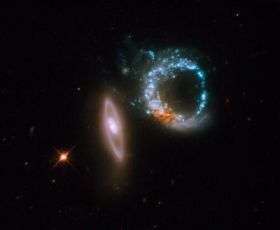Hubble scores a perfect ten

(PhysOrg.com) -- The Hubble Space Telescope is back in business after a one-month breakdown with a snapshot of the fascinating galaxy pair Arp 147. Scientists made two repair attempts, and last week's effort apparently worked.
Just a couple of days after the orbiting observatory was brought back online, Hubble aimed its prime working camera, the Wide Field Planetary Camera 2 (WFPC2), at a particularly intriguing target, a pair of gravitationally interacting galaxies called Arp 147.
The image demonstrated that the camera is working exactly as it was before going offline, thereby scoring a "perfect 10" both for performance and beauty.
And literally "10" for appearance too, due to the chance alignment of the two galaxies. The left-most galaxy, or the "one" in this image, is relatively undisturbed, apart from a smooth ring of starlight. It appears nearly edge-on to our line of sight. The right-most galaxy, the "zero" of the pair, exhibits a clumpy, blue ring of intense star formation.
The blue ring was formed after the galaxy on the left passed through the galaxy on the right. Just as a pebble thrown into a pond creates an outwardly moving circular wave, or ripples, an outwardly propagating ring of higher density was generated at the point of impact of the two galaxies. As this excess density collided with outer material that was moving inwards due to the gravitational pull of the two galaxies, shocks and dense gas were produced, stimulating star formation.
The dusty reddish knot at the lower left of the blue ring probably marks the location of the original nucleus of the galaxy that was hit.
Arp 147 appears in the Arp Atlas of Peculiar Galaxies, compiled by Halton Arp in the 1960s and published in 1966. This picture was assembled from WFPC2 images taken with three separate filters. The colours blue, green, and red represent the blue, visible-light, and infrared filters respectively.
The galaxy pair was photographed on 27-28 October 2008. Arp 147 lies in the constellation of Cetus, more than 400 million light-years away from Earth.
Provided by Hubble Information Centre



















